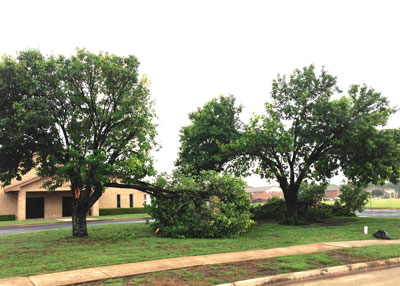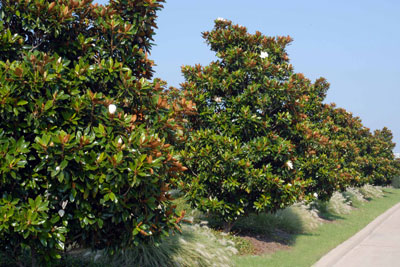Question of the Week 1: March 9, 2017

Photo: Lighting was terrible. Cell phone camera was minimal. Photographer (Neil) was late to a meeting. Photo of Bradford pears split by a storm just a few minutes earlier. There’s hardly any way to salvage trees like this. These people trimmed their trees way back. Now, several years later, they still look like grotesque saguaro cacti.
“Neil, my lovely Bradford pear has just split down the middle. How can I save it? How should I prune it?”
If you like ornamental pears, especially Bradford, this is going to break your heart. These trees, like all other fast-growing trees, have a major fatal flaw. They have notoriously weak branching, and it’s rare for them to live and grow for more than 12 or 15 years before they start splitting into pieces.
The problem comes in their branch angles. You’ll notice that their limbs cluster together tightly. I sometimes refer to them as looking like a fistful of tuning forks that have been squeezed so hard that their handles fused (into the trunk).
As the tree grows and those branches get larger, old bark that would normally fall to the ground gets pinched within those narrow crotches. Moisture is trapped, and decay sets in. Eventually the weight of the limbs pulls down enough that big limbs snap off, and there is almost nothing you can do to stop it. Even cabling won’t help, because the decay just continues to spread within the wood of the trunk.
You might think that you’d be able to trim the branches to more horizontal branching initially, but if you’ve ever tried that with a Bradford pear, you know that’s a really rough assignment.

Photo: Little Gem southern magnolias are a far better choice than Bradford pears.
So where do you turn? Honestly, I advise people who like the growth form of Bradford pears to switch over to Little Gem southern magnolias. They grow to about the same shape and form. They’re evergreen, and they bear showy white blooms in late spring. In all respects, they’re superior trees. Sure they don’t grow nearly as quickly, but you can buy larger specimens initially to get yourself a few years’ head start.
